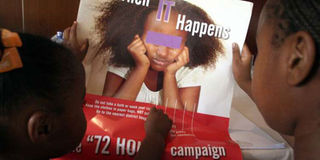Raft of sustainable development goals pledges tougher fight against exploitation

Kenya has become more serious about countering human trafficking. But regardless of government will, she adds, it is important to realise that the reality on the ground is one of massive challenges and limited resources. PHOTO | FILE
What you need to know:
- The International Organisation for Migration’s Noni Munge hopes that the inclusion of an anti-trafficking measure in the SDGs will encourage Kenyan policy makers to prioritise the country’s counter-trafficking response.
- Meanwhile, Kenya’s laws technically allow for victims to seek reparations from convicted traffickers, but the provision has never been used.
Lawyer Prudence Mutiso is hopeful the decision to include a pledge to eradicate the trafficking of humans within a new global development pact will put pressure on the Kenyan government to address the gaping holes in the enforcement of trafficking legislation and implement the support it has promised victims.
The Sustainable Development Goals (SDGs), set to be adopted by the United Nations general assembly later this month, are 17 targets that lay out the global development agenda over the next 15 years. United Nations member states, such as Kenya, are expected to use the SDGs as policy guidelines. The SDGs replace the Millennium Development Goals (MDGs) set by the UN in 2000.
Unlike the MDGs, the Sustainable Development Goals are expected to apply to a broader spectrum of health, environmental and social policy, including a call for measures “to eradicate forced labour, end modern slavery and human trafficking and secure the prohibition and elimination of the worst forms of child labour”.
HAART’s Malinowski is pleased the SDGs will, for the first time, acknowledge human trafficking as a development issue.
MASSIVE CHALLENGES
“What lies at the bottom of trafficking, the ultimate consequence, is that you destroy a crucial component of that society’s development, which is labour capital,” Malinowski explains. “Human trafficking takes promising young people away from society, exploits them, enriches criminal groups and makes crime profitable.”
He adds that the consequences continue even when victims are rescued from their captors. “It brings back wounded people who aren’t only going to have difficulty contributing to national development, but who will also rely heavily on society for support.”
The International Organisation for Migration’s Noni Munge hopes that the inclusion of an anti-trafficking measure in the SDGs will encourage Kenyan policy makers to prioritise the country’s counter-trafficking response.
She acknowledges Kenya has become more serious about countering human trafficking. But regardless of government will, she adds, it is important to realise that the reality on the ground is one of massive challenges, limited resources and difficulties in developing the technical expertise needed to actually address trafficking properly.
“I think this will reinforce Kenya’s efforts,” Munge says. “By including (this measure) in the SDGs, it will reinforce the importance of addressing what is in fact a tragedy of our era.”
While the inclusion of modern slavery and human trafficking in the SDGs may be cause for some optimism, the changes activists hope they may one day help usher in will most likely have little effect on victims today. Victims like Esther.
The lack of government support for people like Esther leaves activists and advocates concerned that there is little chance the young girl will return to school. At the moment, the only help Esther receives comes from non-governmental organisations like HAART and The Cradle.
Even if her alleged abuser is convicted, there is no promise that Esther and her unborn child, also a victim of trafficking, will see any reparations. Esther is allowed to stay in the teen crisis centre she is currently living for only a few weeks after the birth of her baby.
Meanwhile, Kenya’s laws technically allow for victims to seek reparations from convicted traffickers, but the provision has never been used.
“The Cradle can make an application to have the accused commit a few shillings towards the support of her child. That is a requirement of the Victim’s Protection Act and it’s been untested,” says Mutiso. “And it’s high time it is tested.”
What is unclear is whether it will be safe for Esther to return to her parent’s home. This is an exceptionally difficult situation for a girl of her age to deal with, says Khayundi Bwali, the psychologist treating Esther.
VICTIMS' ASSISTANCE
“She shows a lot of dissociative behaviour. Anxiety. Depression. You’ll find that she believes that she can go back to normalcy after all that’s happened. But she won’t be able to,” says Bwali.
On the same day she is told that she will need another medical exam, Esther also finds out that her older sister is pregnant, allegedly abused by the same man who assaulted Esther.
An investigation continues into what role the father may have played in both of his daughter’s cases. If proof is established that he was paid to hand over his children, trafficking charges could be laid against him.
In the meantime, HAART and The Cradle are stepping in to see what assistance could be provided to both girls moving forward. In the absence of a well-resourced, government-funded victims assistance fund, non-governmental organisations will be forced to continue filling an increasingly large services gap.
“We need to see the government taking its role seriously,” says Mutiso of the Victim’s Protection Act. “We cannot have a good society where victims are left on their own.”




